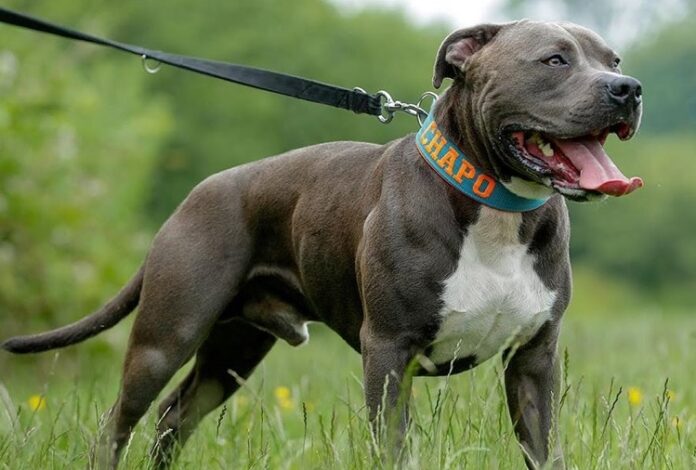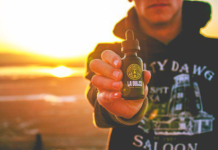A blue nose pitbull is a dog full of happy energy, as anybody who has met one will attest. What’s even better? They each have their distinct hue.
American pit bull terriers, known as “blue noses,” have hair that is a shade between blue and grey. Junior Millan, the blue nose pit bull who belongs to Cesar Millan, the world-famous “dog whisperer” and famed for his “white socks,” is one of the most well-known dogs in the world.
Due to their history of abuse in dogfights, American pit bull terriers have never had the best reputations. Many people don’t know that pit bulls are pretty loving pets that will play with just about everything. Their bulky, muscular appearance belies a friendly, intelligent breed that, with proper training and socialization, can make an excellent addition to any home.
Below you will find comprehensive information about the blue nose pitbull, including its background, appearance, personality, longevity, and training. Questions concerning adopting and caring for a blue nose pitbull are addressed, as with other topics of interest.
Where Did the Blue Nose Pitbull Come From?
The origins of the American pit bull terrier may be traced back to England in the nineteenth century. Bulldogs and English terriers were mated together to produce the now-famous pitbull breed. Solid and robust, these dogs were regarded for their primary function as hunting companions.
Originally from the United Kingdom, where they were known as Staffordshire bull terriers, these dogs were imported to the United States and used as farm and hunting dogs. The American pit bull terrier term was given to these dogs when they were helpful companions and livestock guardians.
Exactly how Blue-Nosed Pitbulls Appear?
The blue nose pitbull is visually indistinguishable from other pit bull terriers, except for its bluish-grey coat. The coat may be uniform in colour or have patterns resembling bridling or tiger striping. Blue-nosed individuals may have white spots on their chests, feet, and sometimes around their eyes.
Due to their athletic ancestry, blue nose pitbull tends to be stocky and broad. They have large, square faces and short snouts. Because of a recessive gene that regulates skin pigmentation, these dogs have a bluish-grey nose. Later, we discuss the typical health problems that arise from this inherited abnormality.
A Blue Nose Pitbull Is About How Big?
The genetic makeup of a litter of blue nose pitbull may cause a wide range of sizes. These canines, however, seldom exceed sixty pounds in weight. In size (often between 18 and 21 inches in height) and weight. Like most others, female dogs tend to be smaller than their male counterparts.
What kind of coat does a blue nose pitbull have?
The blue nose pitbull is distinguished by its shiny coat and short, spiky hair. As a result, their coats are softer to the touch and need less grooming than those of fluffier breeds. Even though they constantly shed, blue nose pit bulls only need to be brushed occasionally. This is excellent news if your dog hates the brush!
What Kind of Personality Does a Blue Nose Pitbull Have?
Because of their friendly, outgoing, and devoted nature, blue nose pitbull are excellent family pets. They also tend to develop deep and meaningful relationships with their human caretakers. However, a restless and dissatisfied pit bull who chews everything in sight results from a lack of exercise and socialization. Pit bulls may develop separation anxiety if left alone for extended periods. Lack of exercise and mental stimulation may make these dogs challenging to live with.
Can You Hug a Blue Nose Pitbull?
Pit bulls with blue noses are known for their kind personalities. In truth, pit bulls are one of the most big-hearted dogs, which means they appreciate a nice snuggle despite their menacing exterior. If you are fortunate enough to share your home with one of these breeds, you will discover that your connection with your pet may be unparalleled.
Is the Blue Nose Pitbull a Family Dog?
Because of their historical affinity for and ease with children, blue nose pitbull have long been known as “nanny dogs” in England. Even now, they have a stellar reputation as one of the most kid-friendly dog breeds. Keep a watch on your pit bull, just like you would any other dog. For instance, an excessively loving pit bull may knock down a toddler.
Do Blue Nose Pitbulls Get Along Well with Other Pets?
Blue nose pit bulls are fantastic with people, but they may be aggressive with other dogs. That’s why it’s crucial to introduce your dog to other animals as early as possible via socialization and obedience training.
Starting early with socialisation is essential if you want your blue nose pitbull to get along well with other animals. Otherwise, they grow unsocial and unfamiliar with interacting with other dogs. Positive reinforcement training and daily walks will go a long way toward making your dog a friendly butterfly.
What About Aggression Among Blue Nose Pitbulls?
More than any other breed, pit bulls tend to be stereotyped and misunderstood by the general public. These dogs are devoted and caring despite their negative reputation. Therefore, remember that pit bulls, like other dogs, are not born with a violent disposition.
However, the agility and muscularity of a pit bull’s physique indicate that it is a robust breed. Therefore, they may cause injury to humans and other dogs if they aren’t adequately socialized and given obedience training. However, positive reinforcement and desensitization strategies may be used to retrain dysfunctional behaviors.
How often do blue nose pitbulls bark?
A blue nose pitbull is one of the most sedate dog breeds available, which is good news if you’re considering getting one. They don’t make a lot of noise. Therefore it might be pleasant to your ears when they don’t bark or howl. Since pit bulls are so infamously silent, they are frequently misunderstood and misrepresented as guard dogs.
Is it true that Blue Nose Pitbulls lack brains?
Pit bulls have a reputation for being very bright. These canines are not only intelligent in terms of their physical intelligence and hunting skills but also in terms of their emotional intelligence. As a result of their intelligence and rapid learning, training a blue nose pitbull is relatively easy. Good news for prospective owners since this breed needs consistent training to rein in their natural aggression and stubbornness.
Can a Blue Nose Pitbull be Trained Quickly?
Unlike other dog breeds, Pitbulls are simple to train. They’re more inclined to listen to their master and can be trained with fewer tries. Remember that blue nose pit bulls need a lot of exercise and attention to stay under control. For instance, a pit bull that hasn’t been exercised enough is less likely to react to directions and more likely to act out in an attempt to release its excess energy.
In addition to playtime, your dog needs to learn the basics of obedience. Professional coaches aren’t required; however, they are useful for picking up extra pointers. In addition to training, early socialization and an even-keeled, authoritative demeanour on your side will go a long way toward maintaining order in your household with the new addition.
Do Blue-Nosed Pitbulls Have a Lot of Energy?
Pit bulls have a lot of vitality. They are also quite childlike and, taken together, can be quite a handful. Therefore, ensure you’re giving your blue-nose pitbull at least 90 minutes of daily exercise, including play, walks, running, etc., every day.
Because of their boundless vitality, blue nose pitbull excel in activities that challenge body and mind, such as agility training and competitive sports. Blue nose pitbulls are incredibly active and like the challenges of an agility course since they were originally developed for hunting; besides leaping, blue nose pit bulls like hobbies like frisbee and other similar games.
Can a Blue Nose Pitbull Live in a Small Space?
A pit bull can make a wonderful pet if you don’t live in a very small flat. Think about how much room your blue-nose pitbull will need to run about and play without damaging your home or things. These dogs are suitable for flat companions because they don’t bark or howl often.
How Trustworthy Are Blue Nose Pitbulls as Guard Dogs?
Pit bulls are powerful and agile but must make better guard dogs. They don’t bark much and would rather play with an intruder than growl at them. Blue nose pit bulls aren’t the best choice if you need a dog that can alert you to intruders promptly. However, these canines are devoted to their masters and will rush to their side in danger.
Nails on bluenose pitbulls, like any other breed of dog, need regular trimming to prevent splitting and overgrowth. Ear wax accumulation may cause infections, so you should check their ears often.
Do Blue-Nosed Pit Bulls Shed?
The shedding cycle of a blue nose pitbull is constant. This means they may skip the regular trip to the salon to have their fur professionally maintained. Because blue nose pit bulls don’t have an undercoat, you won’t have to worry about sweeping up massive amounts of hair once a year.
What Kind of Food Is Best for a Blue Nose Pitbull?
Like pitbull dogs, dogs with a lot of muscle and energy need a diet high in protein and fat. Raw meat, meaty bones, cooked or dried veggies, and fruit are also great options. A pit bull needs around a pound of food daily, equivalent to 1.5 to 2 cups. Male dogs and pups, for example, need more food than female dogs and senior canines, so you’ll need to alter this accordingly.
In what ways do Blue Nose Pitbulls struggle with their health?
Regular veterinary examinations and education on avoiding health problems are essential for pit bull owners due to the prevalence of certain heritable disorders. Here are the top two diseases that might affect your blue nose pittie:
Hip-Dysplasia
Pit bulls often have hip dysplasia. This genetic disorder causes hip joint deformity, which may lead to chronic discomfort and disability. Keep an eye out for signs of illness, such as a dog that has trouble getting up from a laying position or hind-limb lameness. Preventing your dog from experiencing discomfort in the future is possible via regular veterinary checkups and the administration of joint supplements like glucosamine and omega-3 oils.
Atopic Dermatitis
Because of their selective breeding for a distinctive “blue” coat, blue-nose pitbulls are particularly vulnerable to skin allergies. Unfortunately, skin diseases, typically prompted by fleas and other environmental irritants, have arisen due to this kind of breeding. Maintaining a healthy pit bull requires frequent grooming and a keen eye for indications of itching or other skin irritations. If your pit bull is in pain, you may give them special shampoos and antihistamines.
The lifespan of a Blue Nose Pitbull, Approx.
A healthy blue nose pitbull may expect to live between 12 and 15 years. Your pit bull’s lifespan depends on a number of variables, including his or her food, exercise routine, genetics, and overall physical and mental condition.
Do Blue Nose Pitbulls Cost a Lot?
Pitbull dogs are one of the most costly dog breeds since they are so rare. Costs associated with adopting one range from $2,000 to $5,000. Due to the high cost of breeding healthy puppies, a reputed breeder would charge more for their pups. You may not be able to adopt a blue nose pitbull from a shelter, but that doesn’t mean you can’t try.
Where Can I Track Down a Breeder of Blue Nose Pitbulls?
Finding a reliable breeder is essential. Unfortunately, there have been examples of scam artists taking advantage of unsuspecting dog owners by inbreeding puppies to get the desired shade. This is very unethical and dangerous to the dog’s health.
Find a breeder with a high reputation and do your research to make sure you’re not getting scammed. Visit the breeder with a long list of questions if you don’t have any recommendations. One should inquire about the health and temperament of the mother dog and her litter by visiting the home.
It’s also helpful to learn about the breeder’s routines, such as the kind of food the pups are given. Is there evidence of socialization? When did the mother have her first litter? A reputable breeder will also challenge your suitability as a pet parent. They must also have medical documents, such as a certificate of good health and proof of immunization.
Is a Blue-Nosed Pitbull Available for Adoption?
Since blue nose pitbull is so uncommon, you probably won’t find one at your local animal shelter. However, you may still adopt one from a shelter. Find out if any adoptable blue nose pitbulls are available by asking around or researching online. If you do discover one, it’s essential to learn as much as you can about its background so you can prepare for any potential health or behavioural problems before bringing it to your pack.
Is There a Purebred Line of Blue Nose Pitbulls?
Authentic American pit bull terriers have a blue nose. Check the pit bull’s physical traits to be sure you’re getting a purebred. A healthy and muscular build is ideal for Pitbulls. Despite their rising popularity and purity, the American Kennel Club still does not recognize blue nose pitbulls as a recognized breed.
Blue-Nosed Pit Bull Dog Exposed
Should First-Time Dog Owners Consider a Blue Nose Pitbull?
Although blue nose pit bulls are great with children and other family members, they may be a lot of work for their owners. Therefore, this may not be the greatest breed to adopt initially if you are a first-time dog owner apprehensive or anxious about canines.
Because of their strength, pit bulls may be challenging to handle if they have not been properly socialized and trained. Blue nose pitbulls are known for their great intelligence, which makes them an excellent family companion if you’re up to the challenge.
FAQs
Which Service Dogs Fare Best? Blue Nose Pitbulls?
Whether for a person with a physical or mental impairment, a blue nose pitbull makes a wonderful service dog. They are tall, heavy, and physically robust, making them perfect for dragging a wheelchair or offering other forms of assistance. In addition to being wonderful companions, emotional support, or mental care animals, blue nose pitbulls are well-known for their high devotion and loyalty.
How to Take Care of a Pitbull with a Blue Nose?
The needs of a blue nose pitbull are no different from those of any other dog, but special attention must be paid to the breed’s unique traits. For instance, you should use a pH-balanced, flea- and tick-controlling shampoo on your blue nose pitbull since these dogs are prone to skin problems.
Exercising your blue nose pit bull is also an important part of caring for your pet. Problems like separation anxiety, frustration, and even hostility may develop in a dog left alone for long periods. Finally, ensure you give your blue nose pitbull attention, consistency in feeding, and appropriate punishment; it needs to be a content family member.
Does Blue-Nosed Pitbulls Require Special Care?
Pit bulls need little in the way of upkeep in terms of grooming. They don’t have to be brushed or bathed very often since their short, rigid coats don’t shed. Keep in mind that brushing is necessary for the removal of dead hair and skin and the maintenance of a healthy coat.
Conclusion!
Is a blue nose pitbull the correct breed for you? You should think carefully about whether or not your personality and way of life are suited to this breed before making a final decision. In general, a blue nose pitbull would be an excellent choice for you if you:
Adopting a dog is a highly individual decision. However, blue nose pitbulls make excellent pets. These devoted canines are great company and may bring a lot of laughter into your home. A blue nose pitbull is a loyal and faithful pet if you provide sufficient mental and physical stimulation.

















